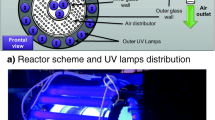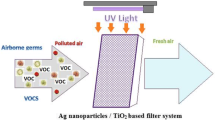Abstract
Airborne microorganisms can cause various adverse effects, including infectious, allergic, and immunotoxic diseases. Bioaerosols are also one of the main causes of morbidity and mortality, as well as a heavy burden on health costs. The present study models and compares the inactivation performance of three commercial air filters, industrial and domestic use (vacuum cleaner) with and without catalyst (TiO2) deposition for a model microorganism under UVA radiation. The filters were studied regarding catalysis load, adherence, optical properties, morphology, and cost. The microorganism used was E. coli, it was distributed emulating Flügge droplets on coated and uncoated filters and then exposed to UVA radiation at different humidity conditions. Different methods of bacterial spreading and counting on filters were tested. A simple kinetic model was proposed and validated to compare the inactivation performances of photocatalysis and photolysis; the modeling results enabled the prediction of inactivation efficiency and analysis of several parameters. To compare the photocatalytic activity of the functionalized filters we calculated D90, the dose to reduce one bacterial log, and a pseudo-constant of the inactivation rate per unit mass of catalyst deposited. Our experimental findings of TiO2-coated fiberglass filters presented in this study suggest that scaling up and its subsequent development in ventilation systems would be successful.






Similar content being viewed by others
Data availability
Data will be made available on request.
References
Ahlawat A, Wiedensohler A, Mishra SK (2020) An overview on the role of relative humidity in airborne transmission of SARS-CoV-2 in indoor environments. Aerosol Air Qual Res 20:1856–1861. https://doi.org/10.4209/aaqr.2020.06.0302
Ahmadi A, Bhardwaj N, Kim K-H, Kumar S (2021) Recent advances in photocatalytic removal of airborne pathogens in air. Sci Total Environ 794:148477. https://doi.org/10.1016/j.scitotenv.2021.148477
Asadzadeh-Khaneghah S, Habibi-Yangjeh A (2020) g-C3N4/carbon dot-based nanocomposites serve as efficacious photocatalysts for environmental purification and energy generation: A review. J Clean Prod 276:124319. https://doi.org/10.1016/j.jclepro.2020.124319
ASHRAE (2017) Interpretation for standards. https://www.ashrae.org/technical-resources/standards-and-guidelines/standards-interpretations/interpretations-for-standard-52-2-2007. Accessed 20 October 2023
Carbajo J, Tolosana-Moranchel A, Casas JA, Faraldos M, Bahamonde A (2018) Analysis of photoefficiency in TiO2 aqueous suspensions: effect of titania hydrodynamic particle size and catalyst loading on their optical properties. Appl Catal B Environ 221:1–8. https://doi.org/10.1016/j.apcatb.2017.08.032
Chen Y-H, Yan C, Yang Y-F, Ma J-X (2021) Quantitative microbial risk assessment and sensitivity analysis for workers exposed to pathogenic bacterial bioaerosols under various aeration modes in two wastewater treatment plants. Sci Total Environ 755:142615. https://doi.org/10.1016/j.scitotenv.2020.142615
Collins D, Farmer D (2021) Unintended consequences of air cleaning chemistry. Environ Sci Tech 55(18):12172–12179. https://doi.org/10.1021/acs.est.1c02582
Disassa N, Sibhat B, Mengistu S, Muktar Y, Belina D (2017) Prevalence and antimicrobial susceptibility pattern of E. coli O157:H7 isolated from traditionally marketed raw cow milk in and around Asosa Town, Western Ethiopia. Vet Med Int 2017:1–7. https://doi.org/10.1155/2017/7581531
Dong YY, Zhu YH, Ma MG, Liu Q, He WQ (2021) Synthesis and characterization of Ag@AgCl-reinforced cellulose composites with enhanced antibacterial and photocatalytic degradation properties. Sci Rep 11:3366. https://doi.org/10.1038/s41598-021-82447-2
Ganguly P, Byrne C, Breen A, Pillai SC (2018) Antimicrobial activity of photocatalysts: Fundamentals, mechanisms, kinetics and recent advances. Appl Catal B Environ 225:51–75. https://doi.org/10.1016/j.apcatb.2017.11.018
Gao Y, Tian E, Zhang Y, Mo J (2022) Utilizing electrostatic effect in fibrous filters for efficient airborne particles removal: Principles, fabrication, and material properties. Appl Mater Today 26:101369. https://doi.org/10.1016/j.apmt.2022.101369
Guillard C, Bui T-H, Felix C, Moules V, Lina B, Lejeune P (2008) Microbiological disinfection of water and air by photocatalysis. C R Chim 11:107–113. https://doi.org/10.1016/j.crci.2007.06.007
Habibi-Yangjeh A, Asadzadeh-Khaneghah S, Feizpoor S, Rouhi A (2020) Review on heterogeneous photocatalytic disinfection of waterborne, airborne, and foodborne viruses: Can we win against pathogenic viruses. J Colloid Interface Sci 580:503–514. https://doi.org/10.1016/j.jcis.2020.07.047
Huang S-M, Weng C-H, Tzeng J-H, Huang Y-Z, Lin L-T, Yen C-J, Chang Y-T (2020) Photocatalytic inactivation of Klebsiella pneumoniae by visible-light-responsive N/C-doped and N-tourmaline/palladium-C-codoped TiO2. Chem Eng J 379:122345. https://doi.org/10.1016/j.cej.2019.122345
Kot M, Wojcieszak R, Janiszewska E, Pietrowski M, Zieliński M (2021) Effect of modification of amorphous silica with ammonium agents on the physicochemical properties and hydrogenation activity of Ir/SiO2 catalysts. Materials 14:968. https://doi.org/10.3390/ma14040968
Kowalski W (2009) UVGI for air and surface disinfection. In: Ultraviolet germicidal irradiation handbook, 1st edn. Springer, Berlin, Heidelberg, pp XVII, 501. https://doi.org/10.1007/978-3-642-01999-9
Lee Y-H, Lee B-K (2006) Inactivation of Airborne E. coli and B. subtilis bioaerosols utilizing thermal energy. J Microbiol Biotech 16:1684–1689. 1017–7825(pISSN) / 1738–8872(eISSN)
Levy S, Islam MS, Sobur MA, Talukder M, Rahman MB, Khan MFR, Rahman MT (2020) Molecular detection of avian pathogenic Escherichia coli (APEC) for the first time in layer farms in Bangladesh and their antibiotic resistance patterns. microorganisms. Microorganisms 8(7):1021. https://doi.org/10.3390/microorganisms8071021
Liu J, Tian E, Zhang S, Kong D, Liu K, Bai X, Liu K (2022) The rise of two-dimensional-material-based filters for airborne particulate matter removal. Adv Fiber Mater 5:461–483. https://doi.org/10.1007/s42765-022-00242-8
Luo H, Zhong L (2021) Ultraviolet germicidal irradiation (UVGI) for in-duct airborne bioaerosol disinfection: Review and analysis of design factors. Build Environ 197:107852. https://doi.org/10.1016/j.buildenv.2021.107852
Mamaghani AH, Haghighat F, Lee C-S (2017) Photocatalytic oxidation technology for indoor environment air purification: the state-of-the-art. Appl Catal B Environ 203:247–269. https://doi.org/10.1016/j.apcatb.2016.10.037
MartínezRetamar ME, Passalía C, Brandi R, Labas MD (2019) Dose estimation methodology for the UV inactivation of bioaerosols in a continuous-flow reactor. Aerosol Sci Tech 53:8–20. https://doi.org/10.1080/02786826.2018.1533914
MartínezVimbert R, ArañóLoyo M, Custodio Sánchez D, Garcia Raurich J, Monagas Asensio P (2020) Evidence of OH radicals disinfecting indoor air and surfaces in a harmless method for humans. Int J Eng Res Sci 6(4):1–13. https://doi.org/10.5281/zenodo.3767883
Morris AC, Sharrocks K, Bousfield R, Kermack L, Maes M, Higginson E, Forrest S, Pereira-Dias J et al (2022) The removal of airborne severe acute respiratory syndrome coronavirus 2 (SARS-CoV-2) and other microbial bioaerosols by air filtration on Coronavirus Disease 2019 (COVID-19) surge units. Clin Infec Dis 75:97–101. https://doi.org/10.1093/cid/ciab933
Nag R, Monahan C, Whyte P, Markey BK, O’Flaherty V, Bolton D, Fenton O, Richards KG, Cummins E (2021) Risk assessment of Escherichia coli in bioaerosols generated following land application of farmyard slurry. Sci Total Environ 791:148189. https://doi.org/10.1016/j.scitotenv.2021.148189
Nunayon SS, Zhang HH, Chan V, Kong RYC, Lai ACK (2022) Study of synergistic disinfection by UVC and positive/negative air ions for aerosolized Escherichia coli, Salmonella typhimurium, and Staphylococcus epidermidis in ventilation duct flow. Indoor Air e12957. https://doi.org/10.1111/ina.12957
Passalía C, Nocetti E, Alfano O, Brandi RJ (2017) Coated mesh photocatalytic reactor for air treatment applications: comparative study of support materials. Environ Sci Pollut Res 24:6382–6389. https://doi.org/10.1007/s11356-016-7057-7
Rattanakul S, Oguma K (2018) Inactivation kinetics and efficiencies of UV-LEDs against Pseudomonas aeruginosa, Legionella pneumophila, and surrogate microorganisms. Water Res 130:31–37. https://doi.org/10.1016/j.watres.2017.11.047
Tian TD, Zhou H, Zhang H, Zhou P, You J, Yao G, Pan Z, Liu Y, Lai B (2022) Heterogeneous photocatalyst-driven persulfate activation process under visible light irradiation: From basic catalyst design principles to novel enhancement strategies. Chem Eng J 428:131166. https://doi.org/10.1016/j.cej.2021.131166
Tripp GK, Good KL, Motta MJ, Kass PH, Murphy CJ (2016) The effect of needle gauge, needle type, and needle orientation on the volume of a drop. Vet Ophthal 19:38–42. https://doi.org/10.1111/vop.12253
Wang C, Lu S, Zhang Z (2019) Inactivation of airborne bacteria using different UV sources: Performance modeling, energy utilization, and endotoxin degradation. Sci Total Environ 655:787–795. https://doi.org/10.1016/j.scitotenv.2018.11.266
WHO global air quality guidelines (2021) Particulate matter (PM2.5 and PM10), ozone, nitrogen dioxide, sulfur dioxide and carbon monoxide. World Health Organization, Geneva. License: CC BY-NC-SA 3.0 IGO
Wolkoff P (2018) Indoor air humidity, air quality, and health – an overview. Int J Hyg Environ Health 221:376–390. https://doi.org/10.1016/j.ijheh.2018.01.015
Yakupoğulları Y, Otlu B, Çelik B, Gözükara Bağ HG (2019) Performance of MALDI-TOF MS for the identification of gram-negative bacteria grown on eosin methylene blue (EMB) agar: A simple method for improving the effectiveness of identification]. Mikrobiyol Bul 53(1):1–11. Turkish. https://doi.org/10.5578/mb.67523
Yoon YH, Nam S-H, Joo J-C, Ahn H-S (2014) Photocatalytic disinfection of indoor suspended microorganisms (Escherichia coli and Bacillus subtilis spore) with ultraviolet light. J Korea Academia-Industrial Cooperation Society 15:1204–10. https://doi.org/10.5762/KAIS.2014.15.2.1204
Acknowledgements
The authors would like to thank Universidad Nacional del Litoral (UNL), Consejo Nacional de Investigaciones Científicas y Técnicas (CONICET), and Agencia Nacional de Promoción Científica y Tecnológica (ANPCyT) of Argentina for their continuous support throughout this study.
Funding
This work was funded by the Agencia Nacional de Promoción Científica y Tecnológica (PICT 2017–2090) and Universidad Nacional del Litoral (CAID 50620190100162Li).
Author information
Authors and Affiliations
Contributions
Marina Flores performed the experiments and data collection. All authors designed the study and analyzed all the data. Marina Flores, Marisol Labas and Rodolfo Brandi made theoretical calculations.
Marina Flores and Claudio Passalía wrote the main manuscript text and prepared the figures and tables. Marisol Labas and Rodolfo Brandi: obtained funding for the research. All authors reviewed the manuscript, made amendments, and contributed with their expertise.
Corresponding author
Ethics declarations
Competing interests
The authors have no relevant financial or non-financial interests to disclose.
Ethical approval
Not applicable.
Consent for publication
Not applicable.
Additional information
Publisher's Note
Springer Nature remains neutral with regard to jurisdictional claims in published maps and institutional affiliations.
Supplementary Information
Below is the link to the electronic supplementary material.
Rights and permissions
Springer Nature or its licensor (e.g. a society or other partner) holds exclusive rights to this article under a publishing agreement with the author(s) or other rightsholder(s); author self-archiving of the accepted manuscript version of this article is solely governed by the terms of such publishing agreement and applicable law.
About this article
Cite this article
Flores, M., Passalía, C., Labas, M.D. et al. Study of photocatalytic inactivation of airborne microorganisms on various functionalized filter media: comparative analysis. Air Qual Atmos Health (2024). https://doi.org/10.1007/s11869-024-01539-w
Received:
Accepted:
Published:
DOI: https://doi.org/10.1007/s11869-024-01539-w




